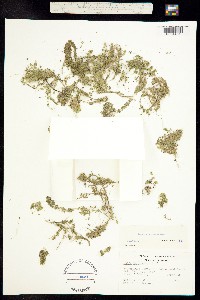|
|
Origin:
Native
Life Cycle:
Perennial Similar Species: Lemna aequinoctialis, L. minor, L. perpusilla
General Desc:
Aquatic plant forming large colonies; spreads rapidly. It has small, stemless, green, leaf-like fronds which float, singly or in small groups, on the water's surface. Each frond has a single, reddish, thread-like root dangling below it in the water.
Identification notes: Plants form olive to brown, rootless wintering buds, which sink to bottom. Root sheath not winged; roots often >1 inch, tips rounded; fronds (leaf-like parts) often reddish tinged, 3 to 5 veined, float, margins smooth, 1 to 1-1/2 times long as wide.
Height:
To about 1/16 inch
Habitat Description: Quiet, shallow water of lakes, ponds, river bottoms, swamps and marshes as well as slow-moving streams, stream pools (areas in a stream where the water is somewhat deeper) and beaver flowages (areas flooded by beaver dams).
Plant Communities:
Riparian
Elevation: 5000 - 9000 feet
Color:
Whitish
Shape:
Inconspicuous not in clusters
Tubular:
N
Flowering Period:
Jun - Aug
Description:
Often there is 1 tiny flower (rarely 2) per plant. They are held in 2 side pouches near the base of the plant with a narrow opening at the top. Flowers lack petals and sepals but have 2 stamens and a single style. However, flowers are seldom produced.
Leaf Color:
Green above, tinged red below
Leaf Type:
Simple
Leaf Shape:
Round or oval
Leaf Margin:
Smooth
Leaf Attachment:
Other
Leaves Clasp:
N
Hairs:
No
Spines:
N
Leaf Description:
Fronds are 1/16 to 1/8 inch long, have a flat oval shape with rounded tips and are widest at or above the middle. They are 1 to 1-1/2 times longer than wide. Fronds have tiny raised bumps along the midvein above and are tinged with red or purple below.
Fruit Notes: The fruit is called a utricle. It is tiny, less than 1/16 inch long, thin-walled, may have 1 to several seeds and is bladder-like with a narrow opening at the top. When ripe, it does not split open to release the seed.
Seed Notes: Seeds are smooth with 30 to 60 light veins. After fruit ripens, the seed stays within the fruit wall so that reproduction is mainly by special buds called turions which overwinter on the water bottom. In spring, they resurface, growing into a new plant.
|
|
